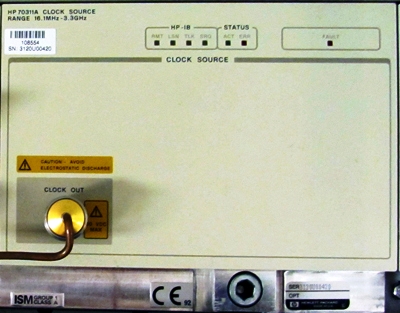
|
|
The HP 70311A Clock Source is part of the Hewlett-Packard Modular Measurement System (MMS) for the 71600 series of error performance analyzers and patern generators. It is a synthesized clock source designed to operate from 16 to 3300 MHz. It has eight frequency bands, which allow for finer signal tuning. Signal paths are changed with and within frequency bands to select filtering to meet output specifications at all target frequencies. The Agilent 70311A has a frequency resolution of 0.01 Hz across the entire range, with a minimum frequency step size of 0.01 Hz, and a maximum step size of 1 GHz. Using the internal reference source, the timebase 1 year aging rate is +/- 2 ppm nominally, and +/- 6 ppm/year at temperatures from 0 to 45 degrees C. To be within 100 Hz of final frequency and to be within level specification takes less than 200 ms. The output connector is a female N-type that has an impedance of 50 ohms. It is ac coupled, outputing a sine wave, which is protected from any damadge with any load VSWR. The output connector is a female N-type that has an impedance of 50 ohms. It is ac coupled, outputing a sine wave, with no damadge with any load VSWR. The maximum power that can be applied to the output is +20 dBm and the maximum applied output voltage is 30 V. The typical return loss is 6 dB. The output level with the output switched on is 0 dBm +/- 3 dB and < -50 dBm with the output switched off. The sub-harmonic levels are at less than -55 dBc in a frequency range of 515 to 1030 MHz, less than -40 dBc from 1030 to 2060 MHz, and less than -35 dBc from 2060 to 3300 MHz. Harmonics across the entire frequency range occur at levels lower than -30 dBc. Non-harmonic spurious frequency tones at an >15 kHz offset occur at levels < -100 dBc from 16 to 1030 MHz, < -94 dBc from 1030 to 2060 MHz, and < -88 dBc from 2060 to 3300 MHz. Phase noise using the internal reference source with a 20 kHz offset, at frequencies from 16 to 128 MHz occurs at -140 dBc/Hz. Phase noise occurs at -138 dBc/Hz at frequencies from 128 to 257 MHz, -134 dBc/Hz at frequencies from 257 to 515 MHz, -128 dBc/Hz at frequencies from 515 to 1030 MHz, -121 dBc/Hz from 1030 to 2060 MHz, and -115 dBc/Hz from 2060 to 3300 MHz. The broadband noise floor at >10 MHz offset from carrier is typicaly < -140 dBc/Hz. The external reference input, found on the rear panel, is an SMB male connector, with an input impedance of 50 ohms and a maximum input power of +20 dBm. The input accepts a frequency of 10 MHz +/- 1 kHz with an amplitude of 0.224/2 V rms. The module can be controlled using an MMS display such as the HP 70004A display. The model 70311A also contains an internal non-volatile storage, which can hold up to 10 instrument setups.
|